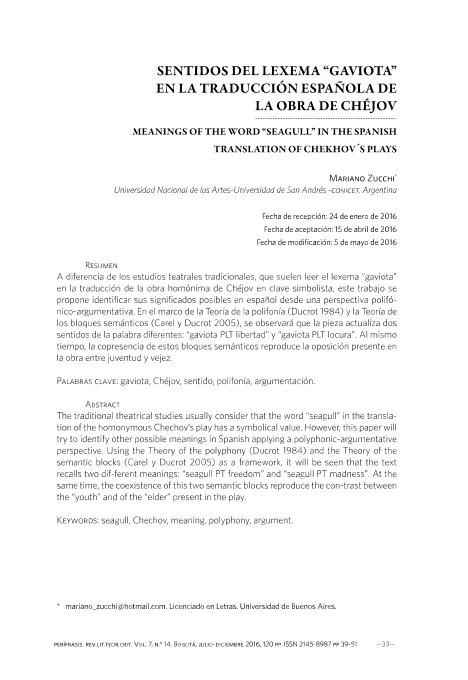Mostrar el registro sencillo del ítem
dc.contributor.author
Zucchi, Mariano Nicolás

dc.date.available
2020-09-25T20:38:11Z
dc.date.issued
2016-08
dc.identifier.citation
Zucchi, Mariano Nicolás; Sentidos del lexema “gaviota” en la traducción española de la obra de Chéjov: Un análisis desde la Teoría de los bloques semánticos; Facultad de Artes y Humanidades. Universidad de los Andres; Revista Perífrasis; 7; 14; 8-2016; 39-51
dc.identifier.issn
2145-8987
dc.identifier.uri
http://hdl.handle.net/11336/114908
dc.description.abstract
A diferencia de los estudios teatrales tradicionales, que suelen leer el lexema “gaviota” en la traducción de la obra homónima de Chéjov en clave simbolista, este trabajo se propone identificar sus significados posibles en español desde una perspectiva polifónico-argumentativa. En el marco de la Teoría de la polifonía (Ducrot 1984) y la Teoría de los bloques semánticos (Carel y Ducrot 2005), se observará que la pieza actualiza dos sentidos de la palabra diferentes: “gaviota PLT libertad” y “gaviota PLT locura”. Al mismo tiempo, la copresencia de estos bloques semánticos reproduce la oposición presente en la obra entre juventud y vejez.
dc.description.abstract
The traditional theatrical studies usually consider that the word “seagull” in the translation of the homonymous Chechov’s play has a symbolical value. However, this paper will try to identify other possible meanings in Spanish applying a polyphonic-argumentative perspective. Using the Theory of the polyphony (Ducrot 1984) and the Theory of the semantic blocks (Carel y Ducrot 2005) as a framework, it will be seen that the text recalls two dif-ferent meanings: “seagull PT freedom” and “seagull PT madness”. At the same time, the coexistence of this two semantic blocks reproduce the con-trast between the “youth” and of the “elder” present in the play.
dc.format
application/pdf
dc.language.iso
spa
dc.publisher
Facultad de Artes y Humanidades. Universidad de los Andres
dc.rights
info:eu-repo/semantics/openAccess
dc.rights.uri
https://creativecommons.org/licenses/by-nc-sa/2.5/ar/
dc.subject
GAVIOTA
dc.subject
CHEJOV
dc.subject
SENTIDO
dc.subject
SEMANTICA
dc.subject.classification
Artes escénicas

dc.subject.classification
Arte

dc.subject.classification
HUMANIDADES

dc.title
Sentidos del lexema “gaviota” en la traducción española de la obra de Chéjov: Un análisis desde la Teoría de los bloques semánticos
dc.title
Meanings of the word “seagull” in the spanish translation of Chéjov´s play: A polyphonic-argumentative perspective
dc.type
info:eu-repo/semantics/article
dc.type
info:ar-repo/semantics/artículo
dc.type
info:eu-repo/semantics/publishedVersion
dc.date.updated
2020-09-24T17:30:32Z
dc.journal.volume
7
dc.journal.number
14
dc.journal.pagination
39-51
dc.journal.pais
Colombia

dc.journal.ciudad
Bogotá
dc.description.fil
Fil: Zucchi, Mariano Nicolás. Universidad Nacional de las Artes; Argentina. Universidad de San Andrés; Argentina. Consejo Nacional de Investigaciones Científicas y Técnicas; Argentina
dc.journal.title
Revista Perífrasis
dc.relation.alternativeid
info:eu-repo/semantics/altIdentifier/url/http://www.scielo.org.co/scielo.php?script=sci_arttext&pid=S2145-89872016000200004&lang=es
Archivos asociados
